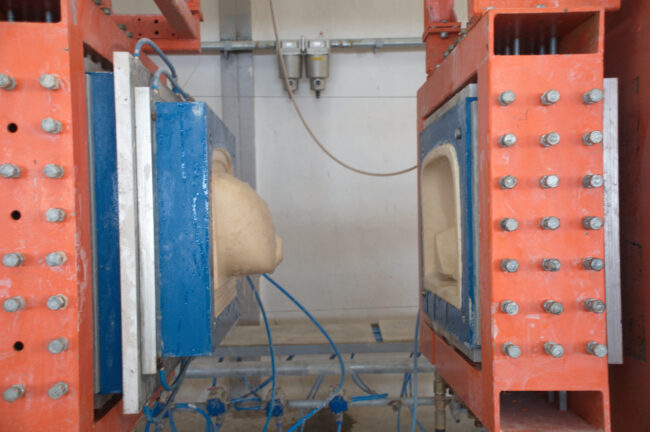Slip casting is a forming technique for ceramics. A liquid clay body slip (porcelain, stoneware, bone china, vitreous china (VC), fine fire clay (FCC)), the so-called slip, is poured into an absorbent mold, which allows to form a layer of solid clay (the cast) on the inside wall of the mold.
-
-
- Traditional Slip Casting
-
Traditional slip casting uses plaster molds to allow this to happen. The water in the slip is drawn out into the walls of the plaster mold, leaving an inside layer of solid clay, which hardens over time. When dry, the solid clay can be removed and further processed. The process usually takes at least several hours per article.
It is a time-consuming process and the molds used for slip casting usually have a low toughness due to their high porosity. Plaster molds wear out rather quickly because the pores are eroded from the water that goes through them. Plaster molds must be replaced after every 90 to 130 production cycles.
-
-
- High Pressure (Slip) Casting
-
An alternative is to use porous resin molds instead. For that purpose, High Pressure (Slip) Casting (HPSC/ HPC), or simply Pressure Casting, has been developed as a high-performance production technology.
High Pressure Casting is used amongst others for producing sanitaryware, tableware, and technical or advanced ceramics. The slip is injected under high-pressure ) into porous resin molds and the filtration through the pores of porous resin molds secures articles with adequate hardness, that are ready to be processed further.
Without compromising quality, geometries with considerable demands on function and design can be produced by using High Pressure Casting. The pressure injection even makes the particles bond more firmly resulting in smoother surfaces and improved body strength. The casting cycles for High Pressure Casting are extremely short when compared to the traditional slip casting method, as the cast forms in mere seconds. Also, porous resin molds can be reused for thousands of casting cycles if they are correctly maintained. This means as well that the process is extremely cost-effective when it comes to producing medium or large quantities. If large volumes of complex components are required, High Pressure Casting will deliver with speed and precision.
Nowadays, the number of companies producing High Pressure Casting machines and the numbers of companies using High Pressure Casting for their production process is increasing because of the benefits this technology offers for the ceramic industry. The flexibility and the cost-effectiveness is required to keep up with the competition.


